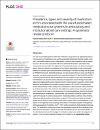Prevalence, types and severity of medication errors associated with the use of automated medication use systems in ambulatory and institutionalized care settings: A systematic review protocol
| Author | Yusuff, Kazeem Babatunde |
| Author | Mustafa, Mariam |
| Author | Al-Qahtani, Najla Hezam |
| Available date | 2022-04-19T10:58:42Z |
| Publication Date | 2021-12-01 |
| Publication Name | PLoS ONE |
| Identifier | http://dx.doi.org/10.1371/journal.pone.0260992 |
| Citation | Yusuff KB, Mustafa M, Al-Qahtani NH (2021) Prevalence, types and severity of medication errors associated with the use of automated medication use systems in ambulatory and institutionalized care settings: A systematic review protocol. PLoS ONE 16(12): e0260992. https://doi.org/10.1371/journal.pone.0260992 |
| Abstract | The use of automated systems within the medication use process has significantly reduce the occurrence of medication errors and the associated clinical and financial burden. However, automated systems lull into a false sense of security and increase the risk of medication errors that are often associated with socio-technical interactions, automation bias, workarounds and overrides. The objective of the systematic review is to determine the prevalence, types and severity of medication errors that are associated the use of automated systems in ambulatory and institutionalized care settings. The search strategy will be guided by PRISMA framework. Selected databases and relevant gray literature were searched and screening was done independently by two researchers between 01 April and 29 June 2021. These covered all relevant articles published from the inception of the use of automation in the medication use process (2000) until 2020. De-duplication and screening of all studies were done independently by two researchers with a clear inclusion / exclusion criteria. Data extraction and synthesis are currently on going (started on 06 July 2021) and being conducted independently but the validity and completeness of the processes will be confirmed by the third researcher. The Cochrane Risk of Bias tool and the Hoy et al's quality assessment checklist will be used for the assessment of methodological bias while the Grading of Recommendations Assessment, Development, and Evaluation (GRADE) system will be used for the quality of evidence assessment. Detailed qualitative synthesis of key findings will be done with thematic and descriptive analyses. If the number and types of included studies permit, fixed or random effect model meta-analysis will be conducted based on the degree of homogeneity in the sampling frame used in the included studies. Heterogeneity will be assessed with I2 statistics and I2 > 50% will be considered a high statistical heterogeneity. The systematic review may provide new perspective especially from developing settings about the prevalence, types and severity of medication errors associated with the use of automated systems at all the stages of medication use process, and in all categories of patients. This may add to global knowledge in the research area. Copyright: |
| Language | en |
| Publisher | Public Library of Science |
| Subject | Drug Therapy Infusion Pumps Prescribing |
| Type | Other |
| Issue Number | 12 December |
| Volume Number | 16 |
| ESSN | 1932-6203 |
Files in this item
This item appears in the following Collection(s)
-
Pharmacy Research [1207 items ]


